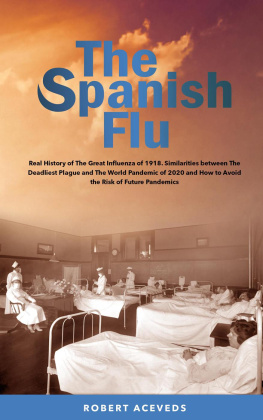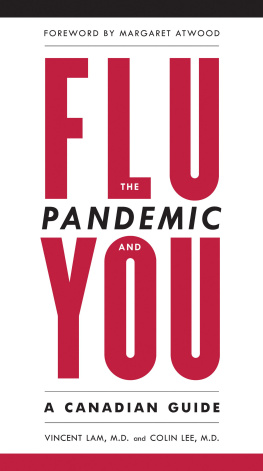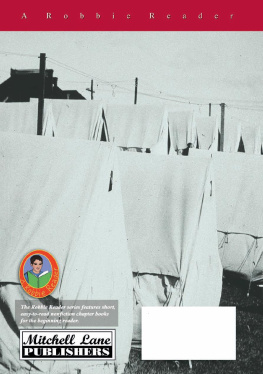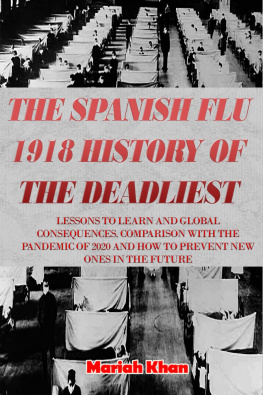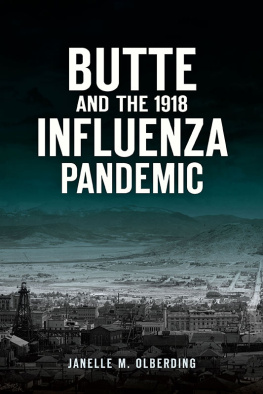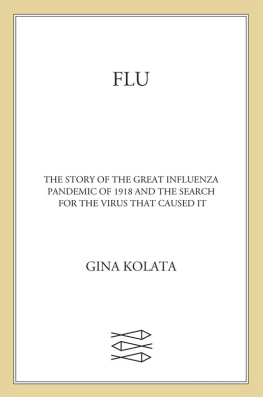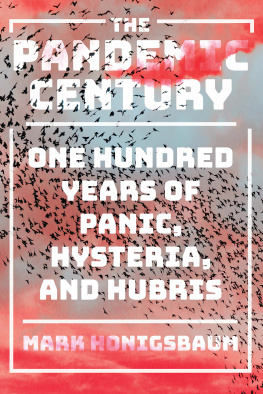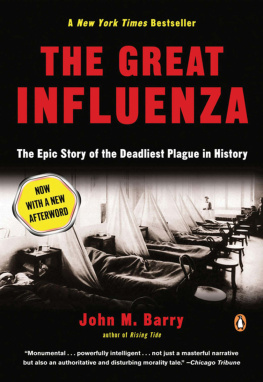1918 Pandemic
Complete Guide on Great Influenza, Historical Analysis of Pandemics and Precious Teachings on How to Deal with Actual and Future Epidemics.
(2 Books in 1)
The Spanish Flu
PANDEMIC
CONTENTS
The Spanish Flu
PANDEMIC.
The Spanish Flu
The Great Pandemic of 1918. The Worst Deadliest Influenza of All Time.
Dr. Peter Gordon
Copyright 2020 by Dr. Peter Gordon. All right reserved.
The work contained herein has been produced with the intent to provide relevant knowledge and information on the topic on the topic described in the title for entertainment purposes only. While the author has gone to every extent to furnish up to date and true information, no claims can be made as to its accuracy or validity as the author has made no claims to be an expert on this topic. Notwithstanding, the reader is asked to do their own research and consult any subject matter experts they deem necessary to ensure the quality and accuracy of the material presented herein.
This statement is legally binding as deemed by the Committee of Publishers Association and the American Bar Association for the territory of the United States. Other jurisdictions may apply their own legal statutes. Any reproduction, transmission or copying of this material contained in this work without the express written consent of the copyright holder shall be deemed as a copyright violation as per the current legislation in force on the date of publishing and subsequent time thereafter. All additional works derived from this material may be claimed by the holder of this copyright.
The data, depictions, events, descriptions and all other information forthwith are considered to be true, fair and accurate unless the work is expressly described as a work of fiction. Regardless of the nature of this work, the Publisher is exempt from any responsibility of actions taken by the reader in conjunction with this work. The Publisher acknowledges that the reader acts of their own accord and releases the author and Publisher of any responsibility for the observance of tips, advice, counsel, strategies and techniques that may be offered in this volume.
INTRODUCTION
T
he Spanish flu, which occurred in 1918, affecting everybody globally, was the deadliest in the history of flu. The virus was highly infectious and surged in a few months. It is believed that the Spanish flu was triggered by H1NI, which caused influenza an infection. The duration of the flu was from the beginning of 1918 to mid-1920, which infected over half a billion people, a time the world's third population. The pandemic happened in four consecutive waves. People estimated 17-50 million lost their lives to this deadliest influenza virus in the history of all human epidemics.
In early 1918, the cause and the spread of human flu, commonly known as influenza A virus of Spanish flu and its associations with swine flu and birds to avian, were mysterious. Despite epidemiologic and clinical resemblances to flu pandemics of 1847, 1889, and even past, many questioned if the fatal disease could be influenza. The question resolved the 1930s when similar viruses, known as H1N1 and related to flu, were isolated from pigs and later from a human being. Subsequently, studies that were done for seroepidemiologic were linked to the 1918 pandemic of both viruses. Consequent research shows that the 1918 virus descendants continue in pigs enzootically.
They constantly circulated in human being, undertaking steady antigenic shift and drift, thus causing the 1950s epidemics. The emergent of Asian Flu (H2N2) in 1957 was directly linked with H1N1 virus-related descendants pandemic strain of 1918, which extincted in people circulation, though the lineage related enzootically in pigs. The H1N1 human virus re-emerged abruptly from a freezer in a laboratory. They endure to move and infect people epidemically and endemically.
CHAPTER 1
SPANISH FLU OF 1918
F
lu or influenza is a virus-related respiratory disease that invades the breathing system, including lungs, nose, and throat caused by A and B viruses of flu. It occurs across the globe, which significantly causes mortality and morbidity every year. The Human flu A and B illnesses cause recurrent flu epidemics nearly every single winter in the U.S. Influenza A viral infection are the primary influenza infections that cause influenza or flu pandemics, which is the global flu epidemics disease. A pandemic occurs when different and new flu viruses emerge, contagious to human beings, and affect many people in the continents and across the globe.
Influenza A virus infection is categorized into two types based on the number of proteins on the virus's superficial layer. They include neuraminidase and Hemagglutinin. Both Hemagglutinin and neuraminidase have 18 and 11 subtypes, respectively. With more than 198 different potential influenzas A subtype groupings, only 131 subtypes have been noticed in natural surroundings. The common types of flu viruses that are highly infectious and regularly circulate in human being include A(H3N2) and A(H1N1). Influenza A types are further classified in diverse hereditary clades and sub-clades. Influenza B infections are categorized into two lineages, which include B/Victoria and B/Yamagata. Both influenza A and B viruses subtypes are classified into particular groups and sub-groups commonly referred to as clades and sub-clades.

Human seasonal influenza virus. Source: CDC, 2019.
The influenza infection is complicated and continually keeps changing. The influenza virus physical arrangement makes it particularly susceptible to minor surface variations in antigens throughout replication, thus making the virus to equivocate the host's defense mechanism. These make the influenza virus infect and re-infect individuals in the ensuing years due to weak body immunity.
Due to variations of the influenza virus, people's immunity to flu is short-term, making large populations vulnerable to influenza in the ensuing year. The disease is a recurrent infection in moderate weather. Influenza A virus contaminates many different animals, including humans, other mammals, pigs, aquatic birds, and horses, while the influenza B virus infects only humans. Influenza A virus is a zoonotic disease, and from time to time, infections in birds and animals jump and affect humans being.
The 1918 Spanish influenza virus was one of the severe pandemics in recent history. The pandemic influenza virus originated from pigs, while the 1957 and 1968 epidemics were said to have come into being from contact with avian species. The habitant regions of the proximity of pigs, birds, and human being played a crucial role in establishing a conducive environment for antigenic drifts and shifts. It is imperative to have an exceptional reconnaissance in such regions.
The Spanish flu presented different signs and symptoms, including fever, higher in children, cough, chills, runny nose, sore throat, muscle ache, headache, and frequently extreme weakness. The virus is contagious, spread mainly through aerosols(airborne), and overcrowding in enclosed spaces. Most people who get infected with the influenza virus recover fully within 1-2 weeks. Nevertheless, severe virus complications can occur, predominantly in older people, children, and other susceptible groups with low immunity due to underlying diseases. The most common possible fatal complication of the influenza virus is bacterial pneumonia, and the other influenza complication is virus-related pneumonia, which is rare but has more severe effects.
The primary method of preventing influenza is by vaccination. Though, due to the continually varying flu viruses composition, the modification of the influenza vaccine each year is a must to match current viruses. These involve getting detailed circulating strains knowledge of different types of influenza virusesthe WHO created an International surveillance network of influenza in 1948 and became in charge of its administration. The administration system comprises 82 countries that have 110 influenza state centers and four other Cooperating Midpoints for WHO Research and Reference on Influenza situated in London, UK, Atlanta, USA, London, UK, and Tokyo, Japan with possibilities of establishing new centers.
Next page

